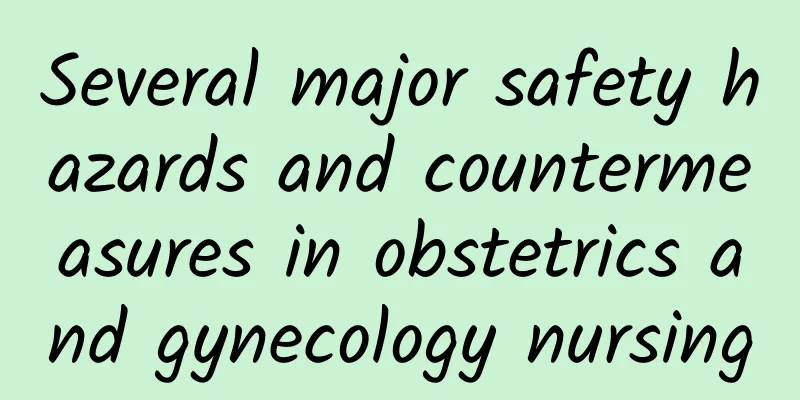Several major safety hazards and countermeasures in obstetrics and gynecology nursing

|
Nursing safety actually means that during the nursing process, if the patient suffers physical or psychological damage beyond the scope prescribed by law, it may even cause problems for the mother and threaten her life. Obstetrics and gynecology is one of the higher-risk departments in the hospital, so the nursing staff in this department have greater responsibilities. As patients become more aware of their legal rights, the issue of nursing safety in obstetrics and gynecology has received more and more attention. Strengthening nursing safety management and improving the quality of nursing services can help reduce the incidence of medical accidents. Today, let us discuss several major safety hazards and countermeasures in obstetrics and gynecology nursing. 1. There is a lack of legal awareness, making it difficult to identify and deal with potential risks in a timely manner To improve the safety of nursing work and protect the rights and interests of patients, nursing staff need to have a deeper understanding of their work. At present, some nursing staff do not accurately assess potential risks and hidden dangers, and ignore the psychological needs and legal rights of patients, which leads to the intensification of nursing-patient disputes and increases the risk of maternal delivery. At the same time, some nursing staff lack work experience, are unfamiliar with nursing processes and systems, and even have an indifferent, impatient or bad attitude towards patients, and lack a sense of responsibility. These problems make patients feel bad, dissatisfied with nursing, and affect the quality of nursing work. Countermeasures: Hospitals should regularly organize nursing staff to study relevant laws and regulations to improve their safety and legal awareness. At the same time, based on the actual situation, formulate appropriate preventive measures and nursing safety management systems, analyze and improve existing safety hazards, continuously improve various countermeasures in nursing work, and truly implement these countermeasures to protect the rights and interests of patients and the safety of nursing work. Nursing staff should also improve their professional quality, continue to learn and accumulate work experience, treat patients warmly and patiently, maintain a sense of responsibility and work enthusiasm, so as to improve the level and quality of nursing work and provide patients with better nursing services. 2. Insufficient communication between medical staff and patients The emotional state of parturients has an important impact on the clinical treatment effect. Parturients are often in a negative emotional state before giving birth, and are more likely to have emotional outbursts after giving birth, such as irritability, anxiety, depression and other negative emotions. Especially after giving birth, due to the sudden relaxation of the mood from tension, the mood of parturients will fluctuate drastically, which makes parturients prone to depression. Some parturients are full of fear and tension about the delivery process, which causes the uterine contractions to intensify and increase the pain. The possibility of postpartum depression will also increase, affecting postpartum recovery. Countermeasures: Good communication can improve patients' negative emotions such as irritability, anxiety, tension, suspicion and uneasiness. Hospitals need to conduct communication skills training, including how to treat parturients and the tone of communication. At the same time, nurses with good communication skills can be invited to share their work experience and advocate joint learning. 3. Lack of drug safety Medication management is crucial for mothers because they may need to take some medications during pregnancy and delivery. Improper medication management may have a serious impact on the safety of mother and baby. For example, drug overdose or drug poisoning may endanger the mother's life; adverse drug reactions may have a negative impact on the fetus, and even cause congenital malformations or other developmental problems; at the same time, drug allergic reactions may also cause harm to mother and baby; drug interactions may reduce the efficacy of certain drugs or increase toxicity. Countermeasures: To ensure the safety of mothers during drug treatment, medical staff need to manage drugs carefully, including accurately assessing the condition, clearly understanding the patient's medical history and medication, understanding the safety and indications of the drugs, reasonably selecting drugs and dosages under the guidance of a doctor, timely monitoring the patient's condition and drug reaction, and communicating and coordinating with the medical team at any time to ensure the safety and efficacy of the mother's medication. 4. Low crisis handling capabilities During the obstetrics and gynecology process, you may face various emergencies, such as abnormal labor: including slow progress of labor, insufficient uterine contraction or uterine rupture. These situations may lead to complications during delivery, such as placental abruption, fetal distress, etc. Postpartum hemorrhage: one of the most common complications after delivery. Postpartum hemorrhage may be caused by many reasons, such as poor uterine contraction, postpartum uterine infection or uterine fibroids. Fetal distress: may be caused by factors such as placental dysfunction, fetal asphyxia or fetal umbilical cord around the neck. These situations require medical staff to take timely measures to ensure the safety of pregnant women and fetuses. Countermeasures: Hospitals should strengthen training and education, provide emergency response guidance and training to nursing teams, and enable them to make correct judgments quickly. Simulation exercises and case discussions should be held regularly to improve the team's collaboration and emergency response capabilities. When facing emergencies, medical staff need to remain calm and professional, make judgments and decisions quickly, and work closely together. At the same time, communicate with patients and their families in a timely manner, explain the situation, and provide support and comfort to reduce their anxiety and fear. In future work, we should focus on the safety hazards in obstetrics and gynecology nursing, strive to improve the medical service system, and enhance the comprehensive quality of the nursing team to maximize the safety and health of pregnant women and fetuses. Only through unremitting efforts and continuous improvement can nursing staff provide better nursing services for every patient and create a safer and more reliable medical environment. (He Wei, Lingshou County People's Hospital, Shijiazhuang City, Hebei Province) |
<<: Unveiling the secrets of allergic cough: How to effectively treat and care for it?
>>: Use your brain to overcome forgetfulness: Tips for restoring memory after a stroke
Recommend
Is implantation bleeding heavy?
Female pregnancy is a very magical process, which...
Why does a pregnant woman have leg pain when sleeping?
During pregnancy, the pregnant woman's physic...
The uterus is sometimes anterior and sometimes posterior
It goes without saying that the uterus plays an i...
Funny Medicine Talk | Rifampicin (with audio)
Your browser does not support the audio tag...
What to eat for heavy menstruation
Every girl must experience a menstrual period eve...
What is the cause of a small pimple on the vulva?
Diseases contracted by the vulva should not be ea...
International Environment: Study shows no link between cell phone radiation and increased cancer risk
When making a call, people are used to holding th...
Will I ovulate right after my period?
Many pregnant mothers who want a baby often wonde...
Brown color after period
Under normal circumstances, the discharge after m...
Funny Talk About Medicine | Children's Cough and Asthma Remedy (with audio)
Your browser does not support the audio tag...
How to treat moderate pelvic effusion
There are many reasons for pelvic effusion. Some ...
What kind of brown sugar is best for women
Brown sugar is a very common thing. It contains a...
Can I eat cantaloupe during my menstrual period?
During menstruation, there are still many things ...
Is there any way to relieve the stomach pain during menstruation?
As a woman, you should pay special attention to t...
[Healthy Life] Tianjin releases recommended Chinese medicine prescriptions for children's respiratory diseases this winter!
at present The peak season for children's res...









